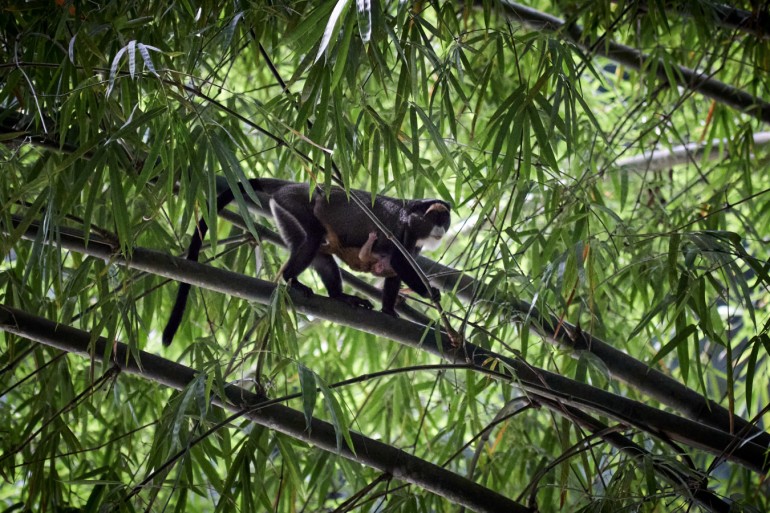

12.05.2023
According to WWF’s Living Planet Report 2022, wildlife populations have plunged an average 69% over the past 48 years. Just as tropical regions are facing a devastating drop, ‘IFO management actions allow the maintenance of populations of priority species Gorilla, Chimpanzee and Forest Elephant and the ecological integrity of the forest.’ With this finding, auditing body Preferred by Nature verified Interholco’s subsidiary IFO in the Republic of Congo for compliance with FSC® Ecosystem Services certification (Forest Stewardship Council, FSC® C022952).

Read the Interholco article published on April 22
Interholco is thus the first forestry company in the Congo basin to receive FSC’s certificate for Biodiversity conservation (ES1). ‘We are witnessing an unprecedented biodiversity crisis. A staggering 66% wildlife population fall in Africa alone is mainly owing to habitat destruction,’ affirmed Tom van Loon, Head of Sustainability at Interholco. He went on to say: ‘Together with WWF, we have been working since 2021 on a landscape project for biodiversity protection, aiming to involve local communities and indigenous peoples. We feel an enormous responsibility and are proud that this new FSC certificate awards our serious efforts.’ The certificate complements FSC Forest Management certification, which IHC already holds.
FSC Ecosystem Services certification looks at the forest holistically, as veritable source of life. How to measure life? FSC recognizes that the forest holds five vital functions or, ‘Ecosystem services’ (ES). Biodiversity protection is under ES 1: the new certificate proofs that Interholco’s rainforest harbours a large population of wildlife, and that biodiversity is maintained. Clearly, ‘biodiversity’ encompasses the larger-than-life variety of a rainforest’s trees and animals. In Interholco’s case, the ES1 certificate established that gorilla, forest elephant and chimpanzee have stable populations. This vitally important forest function is intact also thanks to anti-poaching units patrolling the forest as well as to Reduced Impact Logging (RIL). Data from external wildlife inventories from 2007 and 2014 were taken as a baseline. A new inventory will be done this year.
Protecting biodiversity means animals are protected, along with the habitats that are vital to their survival. Located between two national parks, Interholco’s Ngombe forest is part of a wide biodiversity hotspot, i.e. the tri-national "Dja-Minkebé-Odzala" landscape spanning Cameroon, Congo and Gabon. Visiting in November 2022, the auditors verified on site the ecological integrity of the Ngombe forest. They checked Interholco’s reduced impact (RIL) practices, from the set-aside forest conservation area which will never be touched by harvesting, currently 27% of the total forest concession, all the way to the diameter of harvested trees as well as the number of harvested trees per hectare. The ecological function is largely intact, the auditors found on the ground, thanks to long-established consultation and collaboration with the local population in a process that is best known as, FPIC (Free Prior and Informed Consent). The auditors also established that IFO regularly monitors near real time change in the Ngombé forest via satellite imagery.
The new FSC Ecosystem Services certificate allows for one or more forest functions (Ecosystem Services, ES) to be verified. Interholco selected Biodiversity protection, i.e. ES 1 as possibly the single most significant function, based on its Biodiversity strategy. Biodiversity is so vitally important that all other Ecosystem Services in a forest depend on it. After all, it is precisely because it harbours such a rich variety of fauna and flora species and their habitats (ES1) that a healthy forest can regulate climate functions (ES 2), influencing rains thousands of kilometers away; that it can purify water (ES3) and it can regenerate soil (ES4), all of which turns forests into the sacred place where life is constantly regenerated, a place which all cultures in the world variously worship and long to enjoy (ES5).
In FSC-certified forests, these valuable ecosystem services are protected,' said Gijs Breukink, WWF Forests Forward Co-lead. ‘We would like to show that by managing forest sustainably to protect biodiversity, it is possible to generate additional revenue streams beyond certified timber. This could, for example, fund local communities to maintain important elephant corridors and other species conservation efforts.'
‘Organizations looking to sponsor responsible forestry projects,’ concluded Tom van Loon, Interholco Head of Sustainability ’now have third-party data verifying the real-world impact of their investments on biodiversity and their contribution to the UN’s Sustainable Development Goals (SDGs), all backed by the world’s most trusted name in sustainable forestry’.
Serious about making a difference in the fight against biodiversity loss and climate change? Then, do not settle for anything less than ‘deforestation-free’, ecologically intact forests. Because forests provide a habitat for four-fifths of all land species, support the livelihoods of nearly one-fifth of the world's population, and provide us all with vital services, from supplying fresh water and controlling erosion to regulating the climate.